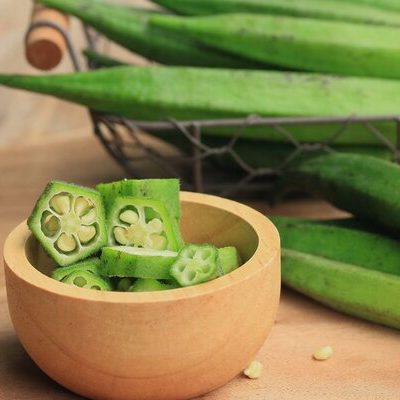
Okra
also known as Okro, Ochro, Ladies’ Fingers
What is Okra?
Okra is the green vegetable pod that grows from the flowering plant Abelmoschus esculentus.
- This plant is part of the mallow or Malvaceae family, which includes hollyhock, cotton, and marsh mallow.
- Okra is recognizable with its long, thin, and tubelike body that is filled with tiny white seeds.
This vegetable is often considered a hit-or-miss food as some people are not fans of its slimy or silky texture. That slime or goo that comes out of this vegetable is known as “mucilage” and can be minimized with various cooking techniques.
The top 10 most popular varieties are:
- Baby Bubba Hybrid
- Blondy
- Burgundy
- Cajun Delight
- Clemson Spineless
- Cow Horn
- Emerald
- Go Big
- Hill Country Road
- Louisiana Green Velvet
Origin of okra
This vegetable’s origin has been traced back to Ethiopia, from where it traveled to North and West Africa, the Middle East, and then India. By the 12th and 13th centuries, the Spanish Moors and Egyptians were using the Arab word for okra. Through trade routes, this vegetable eventually made its way to Brazil in 1658 and later Dutch Guinea. This vegetable would also travel to North America, arriving in New Orleans and much later Philadelphia in the year 1781. Nowadays, this continues to be enjoyed in countries all over the world but especially places with African and Caribbean populations or descendants.
Function
This vegetable is quite popular in the North American south, where it is fried and used much like a pepper. While it is also known for its slime factor, exposing this vegetable to dry heat can help keep it crisp and crunchy. You can toss this vegetable into gumbos or stews if you’re looking for a warm and comforting dish. Otherwise, grilling, sauteing, pan-roasting, and frying are a few other ways to enjoy this late-summer vegetable. It’s also common to pickle or dip okra to bring out another side of this ingredient.
Nutrition
A 100 g serving of okra contains:

This may not be one of the most popular vegetables, although it certainly packs a punch when it comes to nutrients. This vegetable offers the following vitamins and minerals: Vitamin A, Vitamin B6, Vitamin C, Vitamin K, Folate, Magnesium
Unlike many other vegetables, this also offers protein alongside healthy fiber. This food even has antioxidant properties, which can help prevent oxidative damage. Some other health benefits of this vegetable include decreasing the risk of heart disease, possible anticancer properties, reducing blood sugar, and lowering the risk of neural tube defects. The potential health benefits significantly outweigh its unappetizing sliminess, so if you are feeling experimental in the kitchen, you may want to add this to your next recipe.
Commercial Production
The commercial production requires well-drained, fertile soil that can retain a decent amount of water. For best results, this vegetable should be planted in beds where crops have been rotated, as well as the soil turned to give any residue time to decompose. The ideal pH level of the soil used for planting this crop is between 5.8 and 6.5. Once the soil has warmed enough and the seeds germinated, this vegetable takes about 50-60 days to mature depending on the variety planted. After the pods are harvested, they require processing before they can be trimmed and prepared for sale or packaging.
Okra recipes
This vegetable makes a healthy addition to many dishes. Here are some popular recipes:
FDA Regulation
The Food & Drug Administration classifies okra as a rarely consumed raw product and, therefore, does not regulate its growing, harvesting, holding, or packing. The FDA exempts this and other foods from the Produce Safety Rule as these foods need to be cooked before consumption. The organization also has a standard of identity for canned vegetables and notes that it must be derived from the pods of the okra plant.
References
“Okra.” Real Food Encyclopedia, Real Food Encyclopedia, 11 Aug. 2020, foodprint.org/real-food/okra/.
Anderson, Martin. “Okra, or ‘Gumbo,” from Africa.” Aggie Horticulture, Texas AgriLife Extension Services, aggie-horticulture.tamu.edu/archives/parsons/publications/vegetabletravelers/okra.html.
“Okra Seed.” Cals.arizona.edu, College of Agriculture and Life Sciences, University of Arizona, cals.arizona.edu/fps/sites/cals.arizona.edu.fps/files/cotw/Okra_Seed.pdf.
Rizzo, Natalie. “7 Nutrition and Health Benefits of Okra.” Healthline, Healthline Media, 11 July 2019, www.healthline.com/nutrition/okra-health-benefits.
